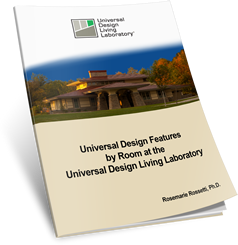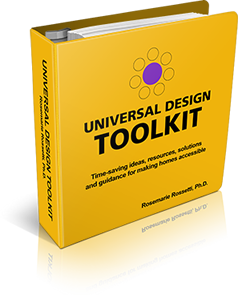
Discover how to live at home more affordably -- with independence, safety and dignity.
Get a sneak-peek at the "Universal Design Toolkit" with this free chapter filled with advice, tips and money-saving resources!

Build your awareness of what universal design features should be incorporated into homes.
Get the newly released "Universal Design Tookit", based on this real life demonstration home.

|
|
Article:
Is Your Friend's Home Visitable?Action Magazine
February 2008
By Rosemarie Rossetti
Copyright © 2008 Rosemarie Rossetti
Publication copyright © 2008 United Spinal Association
|
After a spinal cord injury, where we go and who we visit become more limited. Since my injury in June 1998, I can no longer go to any of my neighbor’s homes and ring their doorbells. Even the two brand new homes a few doors down from me were built with concrete porches and steps that are barriers to me. I would have liked to have welcomed their owners to our neighborhood, but concrete barriers are hard to pass through when you are seated in a wheelchair.
Part of an international effort to make all new homes visitable, Concrete Change (www.concretechange.org) is a project of the Statewide Independent Living Council of Georgia. Eleanor Smith is the mastermind leading this crusade.
Visitability is an effort to have new homes built with a few specific features that make these homes easier for people who develop mobility impairments to live in and visit:
These features provide a person who uses a wheelchair access into a home, use of the bathroom, and access to the interior space to visit with friends and family. When a person is making plans to visit another person’s home for a day, a weekend, or a week, there are many things to consider so the experience will be a pleasant one for all. The disability of the person in the wheelchair needs to be carefully evaluated to insure safety as well as accessibility in the home.
From my experience, friends have been able to accommodate me to be an overnight guest with little expense or effort. My injury is an incomplete paralysis at the T12-L1 level of my spinal cord. I can walk a little using crutches or holding on to a person’s arms. This allows me to walk up the steps of my friend’s home with crutches, especially if there is a handrail. Then someone can bring my wheelchair up the steps and into the house. Portable ramps might also be provided at the entry with the least steps. Good, safe ramps can be rented for these temporary situations. Evaluate all the entrances to the home to determine which one will be the easiest to enter. Make sure the door opening is wide enough (in most cases, at least 32 inches of clear passage space) for the wheelchair.
The width of your wheelchair is an important dimension for your friends to know before your arrival. Measure the distance you need to clear a doorway so your friends can determine which doorways will be limiting and what rooms you will have easy access to. In a pinch, doors can be removed to give a little more clearance. Furniture that is in the way can also be moved in advance of your visit. Your friends can easily envision the space you’ll need by walking around their homes beforehand with a yard stick held horizontally.
Ask that any throw rugs that may be in your path be removed so your wheels won’t get tangled in them. Bare floors or carpeting are much easier to roll on —and safer if you walk with crutches.
If you spend the night, it will be easier if there is a bedroom—or at least a bed—on the fi rst floor. You will need space to transfer and a clear space from the bed to the bathroom. If all the bathrooms and bedrooms are on the second floor, you will need assistance getting up the stairs, unless, of course, there is an elevator.
When you go into the bathroom, make sure all bath towels are placed where you can reach them. If you need to have a raised toilet seat or a shower chair, ask your friend to borrow them and have them available for you. Another option is for you to bring a travel size shower bench with you or use a sturdy lawn chair in the shower. You could also opt to take a bath instead.
Having a disability does complicate traveling at times, but it does not restrict me from taking vacations and visiting with friends. Relationships grow stronger and lives reconnect in a more personal way after quality time is spent in the homes of cherished friends. A little initiative and imagination may be all that is needed to work around a disability in order to visit a friend.
Rosemarie Rossetti, Ph.D. is building a national model universal design home in metropolitan Columbus, Ohio. She is an internationally known speaker, trainer, consultant, and writer. To contact Rosemarie go to: www.RosemarieSpeaks.com. To learn more about the Universal Design Living Laboratory go to: www.UDLL.com.